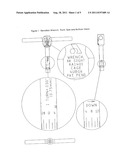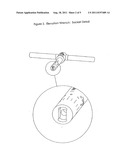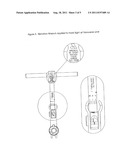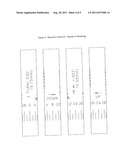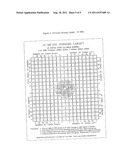Patent application title: Elevation Wrench
Inventors:
Vartan Barsoumian (Las Vegas, NV, US)
IPC8 Class: AF41C2700FI
USPC Class:
42 90
Class name: Firearms implements
Publication date: 2011-08-18
Patent application number: 20110197489
Abstract:
Tools commonly available for this purpose have taken the form of a flat
blade with a central notch, or a tube with a slot through the tip. These
types of tools do not offer sufficient engagement and do not transmit
torque efficiently. Their exposed tabs are vulnerable and often break. At
the tip of the Arsenal wrench is a socket designed to fit the front sight
post. The wall thickness is maximized and the inside corners are filleted
for stress relief. The AK elevation wrench is designed to fit the front
sight post of weapons of the Kalashnikov design. It can adjust elevation
zero by turning clockwise to raise the bullets point of impact and
counterclockwise to lower the point of impact.Claims:
1. The Arsenal elevation wrench is an improved tool for the family of
Kalashnikov weapons, including the AK-47, AKM, AK-74, AK-100 series, RPK
and PKM. It is intended to be used both in the field and at the repair
facilities to adjust the front sight post, which has the form of a
threaded stud with two wrenching flats near the top.Description:
[0001] The Arsenal elevation wrench is an improved tool for the family of
Kalashnikov weapons, including the AK-47, AKM, AK-74, AK-100 series, RPK
and PKM. It is intended to be used both in the field and at the repair
facilities to adjust the front sight post, which has the form of a
threaded stud with two wrenching flats near the top.
DESCRIPTION
[0002] The present invention relates to an improved tool for the family of Kalashnikov weapons, including the AK-47, AKM, AK-74, AK-100 series, RPK and PKM. It is intended to be used both in the field and at the repair facilities to adjust the front sight post, which has the form of a threaded stud with two wrenching flats near the top.
[0003] The product is comprised of the following components: [0004] The AK elevation wrench is designed to fit the front sight post of weapons of the Kalashnikov design, shown in FIGS. 1-5. It can adjust elevation zero by turning clockwise to raise the bullets point of impact and counterclockwise to lower the point of impact. See FIG. 6. The front sight post has a thread pitch of 0.75 mm (0.030), or approximately 38.9 threads per inch. Therefore one complete turn of the front sight post would raise or lower it 0.75 mm. See FIG. 7. The elevation wrench is divided into 32 micrometer numbers; only half of the lines and a quarter of the numbers are marked for better visibility. One number is equal to approximately one-thousandth of an inch. One marked line (2 numbers) is equal to 0.05 mm (0.002) as shown in FIG. 8. One-half turn is 16 numbers (8 marked lines), a quarter turn is 8 numbers (4 marked lines), and so forth. How far to move the sight depends on the range to the target and the sight radius, which is mostly related to barrel length. The typical AK rifle has a barrel length of 16.3 (415 mm). Tables 1 through 5 illustrate the effect of sight adjustment for different weapons at several ranges.
[0005] The body of the wrench is marked with several pieces of relevant information. The thread pitch is marked to indicate the distance moved for each full revolution. The circumference is divided into 32 fractions for precise adjustments. Sixteen of the lines are marked, as well as every fourth graduation, i.e. 0, 4, 8 etc. Also marked on the body is the distance between lines,
GENERAL DESCRIPTION
[0006] The elevation wrench (FIG. 1) is an improved tool for the Kalashnikov series of weapons. It is designed to adjust the threaded front sight post by turning it up or down. Previous tools have neither been able to apply sufficient torque nor given precise adjustments.
[0007] Instead of a slot or prongs, the tip of the sight wrench is formed as a socket. The form fits closely to the diameter of the post and its two wrenching flats. The corners are stress-relieved by small undercut radii (FIG. 2). The strength provided by the support of the socket walls is needed to apply enough torque to move a stubborn or rusted front sight. At the tip the diameter is still small enough to reach a sight post that is at the left or right limits of adjustment (FIG. 3). A long, heavy T-handle is provided to make the application of greater force more comfortable.
[0008] To aid making accurate adjustments, the barrel of the wrench is marked with witness lines (FIG. 4). Tall lines indicate each eighth of a turn, and short lines mark each sixteenth of a revolution. The 1/32 lines are omitted for clarity. The tall lines are marked with the numbers 0, 4, 8, 12, 16, 20, 24, and 28, indicating the fraction of 32 parts. Since the thread pitch is 0.75 mm (0.03 in), these numbers approximately represent the vertical movement of the sight in thousandths of an inch. The distance between lines represents 0.002'', and each 1/8-revolution results in a movement of 0.1 mm (0.004''). For example if the sight post needed to be 0.5 mm lower to zero the rifle, the wrench would be turned clockwise through ten witness lines (10 lines×0.05 mm=0.5 mm). Arrows with the words "UP" and "DOWN" indicate the direction of sight rotation that would cause the raising or lowering, respectively, of the bullet's impact point. Coarse adjustments can be made in quarter turns, which are marked on the target grid that is provided with the tool.
Application and Use
[0009] The AK elevation wrench is designed to fit the front sight post of weapons of the Kalashnikov design. It can adjust elevation zero by turning clockwise to raise the bullet's point of impact and counterclockwise to lower the point of impact. How far the sight is to be moved depends on the range to the target and the sight radius, which is closely related to barrel length. The typical AK rifle has a barrel length of 16.3'' (415 mm). Tables 1 through 5 illustrate the effect of sight adjustment for different weapons at several ranges.
[0010] The sight radius is the distance from the rear sight notch to the front sight post. For any single movement of the front sight post, a weapon with a short sight radius will show a greater bullet position change than one with a longer radius. The tables show how sight changes affect shot placement at different distances. Table 1 covers the AKS-74U submachine gun. These are characterized by a short barrel of 8.3'' (210 mm). Table 2 applies to the current Russian AK-102, -104 and -105 carbines (short rifles), and also the Hungarian AMD-65, AMP-69, and East German MPi-AKS-74NK short assault rifles. These have barrels of 12.4'' (314 mm). Table 3 covers the most common AK assault rifles, to include the AK-47, AKM, and AK-74 and most non-Russian copies. These have a 16.3'' (415 mm) barrel length. Table 4 refers to the RPK light machinegun with a barrel length of 23.2'' (590 mm). Table 5 covers the PK and PKM belt-fed machine gun with a barrel length of 23.9'' (608 mm).
[0011] When using the tools to adjust a sight, it is helpful to pick a fixed reference point on the front sight base from which to add or subtract lines. If possible, begin at the "0" mark, then add lines when turning clockwise and subtract lines when turning counterclockwise. For example, when zeroing a typical AK rifle at 21 meters the bullets are observed to strike the target one inch (25 mm) below the aiming point. At 21 meters table 3 indicates that one quarter turn will move the impact point 0.4 inches (10 mm). To move the bullet impact one inch up requires two-and-a half quarter turns; or plus 20 numbers (10 marked lines) of the micrometer scale.
[0012] When firing a weapon to zero the sights it is desirable to begin at a range that is close enough to ensure that the bullets will strike a reasonably-sized target. Because of the arc of the bullet trajectory, it is possible, for instance, to simulate firing at 300 meters when aiming at a target only 25 meters away. The equivalent target distance depends on the caliber, sight radius, and the height of the front sight above the barrel centerline. Therefore this range will vary for different weapons, including ones of the same family.
[0013] The first step when preparing to zero a weapon is to identify the model and caliber. Only then can the correct target can be selected and placed at the appropriate distance from the muzzle. It is critical that the target is placed at the correct distance from the muzzle. This range is printed on the target. If time and range facilities permit, it is recommended to confirm the zero by firing at a distance of 100 m.
TABLE-US-00001 TABLE 1 AKSU sight radius 9.3'' (235 mm) 15 m 100 m 200 m 300 m 1/32 Turn 0.06'' (1.5 mm) 0.39'' (9.9 mm) 0.78'' (20 mm) 1.2'' (30 mm) .023 mm (.001'') Quarter Turn 0.47'' (12 mm) 3.1'' (79 mm) 6.3'' (159 mm) 9.4'' (238 mm) 0.19 mm (.007'') One Full Turn 1.88'' (48 mm) 12.5'' (317 mm) 25'' (635 mm) 37.5'' (953 mm) 0.75 mm (.030'')
TABLE-US-00002 TABLE 2 AK-Short Rifle sight radius 11.1'' (280 mm) 18 m 100 m 200 m 300 m 1/32 Turn 0.06'' (1.5 mm) 0.33'' (8.3 mm) 0.65'' (17 mm) 1.0'' (25 mm) .023 mm (.001'') Quarter Turn 0.47'' (12 mm) 2.6'' (67 mm) 5.2'' (133 mm) 7.9'' (200 mm) 0.19 mm (.007'') One Full Turn 1.89'' (48 mm) 10.5'' (266 mm) 20.9'' (532 mm) 31.4'' (798 mm) 0.75 mm (.030'')
TABLE-US-00003 TABLE 3 AK sight radius 14.9'' (378 mm) 21 m 100 m 200 m 300 m 1/32 Turn 0.05'' (1.3 mm) 0.24'' (6.2 mm) 0.49'' (12 mm) 0.7'' (19 mm) .023 mm (.001'') Quarter Turn 0.41'' (10 mm) 2.0'' (50 mm) 3.9'' (99 mm) 5.9'' (149 mm) 0.19 mm (.007'') One Full Turn 1.64'' (42 mm) 7.8'' (198 mm) 15.6'' (396 mm) 23.4'' (595 mm) 0.75 mm (.030'')
TABLE-US-00004 TABLE 4 RPK sight radius 21.9'' (555 mm) 26 m 100 m 200 m 300 m 1/32 Turn 0.04'' (1.1 mm) 0.17'' (4.2 mm) 0.33'' (8.4 mm) 0.5'' (13 mm) .023 mm (.001'') Quarter Turn 0.34'' (8.8 mm) 1.3'' (34 mm) 2.7'' (67 mm) 4.0'' (101 mm) 0.19 mm (.007'') One Full Turn 1.38'' (35 mm) 5.3'' (135 mm) 10.6'' (270 mm) 15.9'' (404 mm) 0.75 mm (.030'')
TABLE-US-00005 TABLE 5 PKM sight radius 26.1'' (663 mm) 26 m 100 m 200 m 300 m 1/32 Turn 0.04'' (0.9 mm) 0.14'' (3.5 mm) 0.28'' (7.0 mm) 0.4'' (11 mm) .023 mm (.001'') Quarter Turn 0.29'' (7.3 mm) 1.1'' (28 mm) 2.2'' (56 mm) 3.3'' (85 mm) 0.19 mm (.007'') One Full Turn 1.15'' (29 mm) 4.4'' (113 mm) 8.9'' (225 mm) 13.3'' (338 mm) 0.75 mm (.030'')
User Contributions:
Comment about this patent or add new information about this topic:
| People who visited this patent also read: | |
| Patent application number | Title |
|---|---|
| 20140151625 | NONVOLATILE MEMORY DEVICE USING A VARISTOR AS A CURRENT LIMITER ELEMENT |
| 20140151624 | TARGET, METHOD FOR PRODUCING THE SAME, MEMORY, AND METHOD FOR PRODUCING THE SAME |
| 20140151623 | RESISTIVE RANDOM ACCESS MEMORY DEVICES FORMED ON FIBER AND METHODS OF MANUFACTURING THE SAME |
| 20140151622 | PHASE CHANGE MEMORY |
| 20140151621 | Method of forming anneal-resistant embedded resistor for non-volatile memory application |

